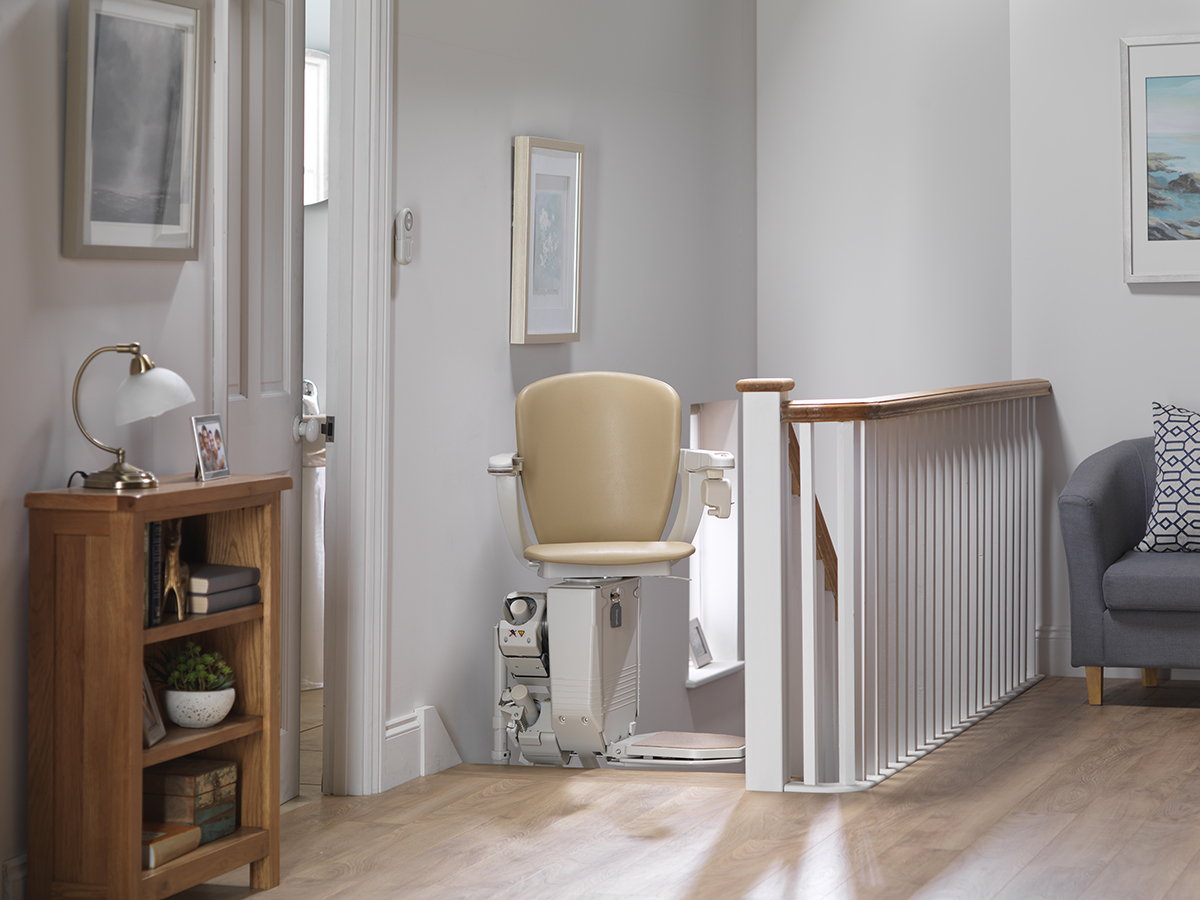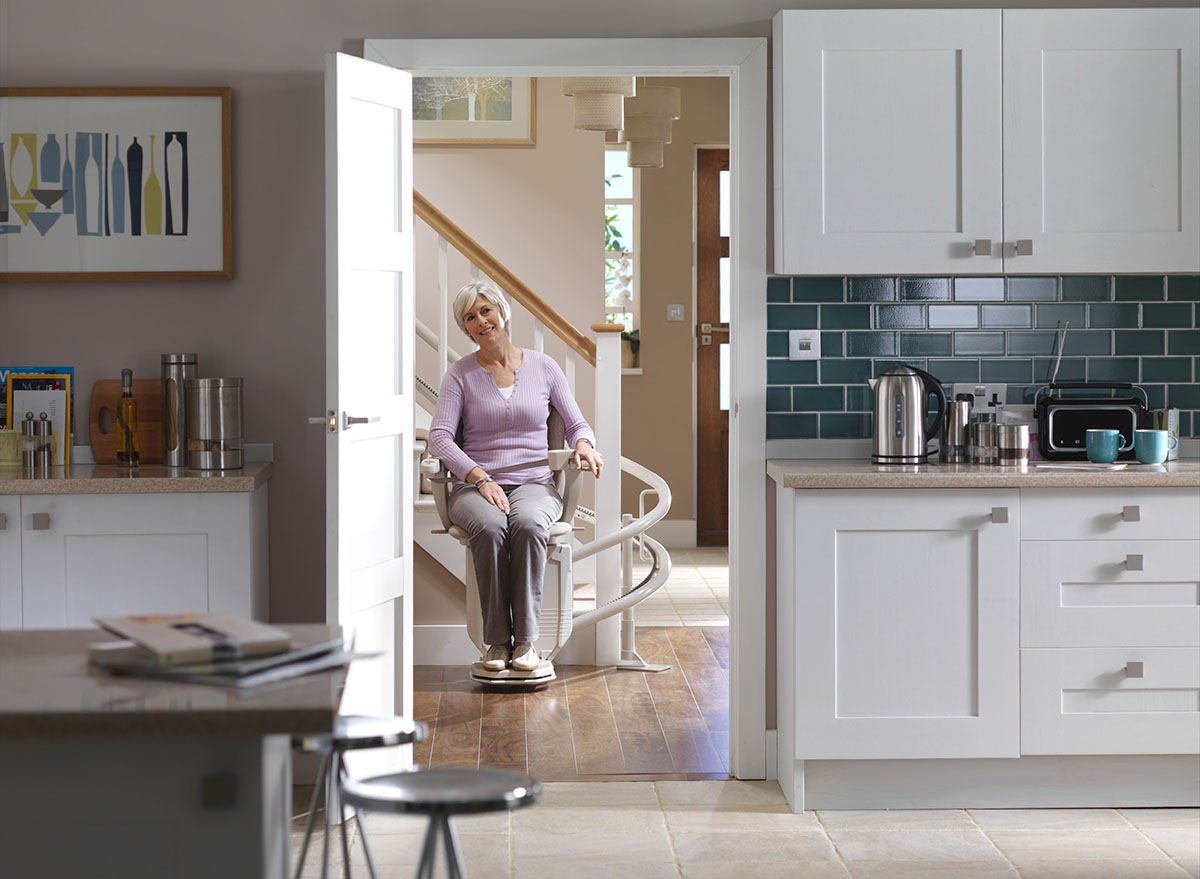Are stairlift safe and what should you look out for?
What kind of safety features should your stairlift have and why? We’ve gathered everything you need to know on your stairlift and safety.
Written by Stannah

Are stairlifts safe?
Yes, not only are stairlift safe, they keep you autonomous by eliminating the stairs as a potential hazard.
Stairlifts were designed for those with reduced mobility to continue to use the stairs independently. Avoiding you having to move house due to such a trivial thing as a staircase.
You might be a senior looking to age in place or someone suffering from reduced mobility looking for a way to independently stay in your own home.
According to the World Health Organization around 28-35% of seniors over 65 fall each year, increasing to 32-42% for those over 70 years, furthermore the falls increase as we get older and frailer.
A fall after the age of 65 is almost never ‘just a fall’. According to the same WHO report, the rate of hospital admissions due to falls for seniors range from 1.6 to 3.0 per 10.000 people. Often resulting in serious conditions, loss of mobility and trauma to name just a few of the consequences. We’ve written an extensive fall prevention guide, where you can read helpful tips on how to stay safe in and around your house.
It’s widely known that most accidents happen in or around the home, but did you know that the most accidents among seniors happen on the stairs and in the bathroom?
Preparing your home for old age can prevent a lot of inconvenience and suffering. For example by installing a walk-in shower instead of a slippery bathtub, or installing a stairlift.
Are stairlifts safe for people who suffer from dementia?
A stairlift is safe when the user can use it independently, you need to be able to safely get on and off the chair and make the trip up and down the stairs.
It’s vital the user understands how to use the stairlift and can do this on their own.
It depends on the stage of the dementia of the user and if there’s a supervisor who can make sure the user travels safely seated on the stairlift. However, using the stairs when you’ve got Dementia without a stairlift, can be considerably more dangerous.
It’s important though that the user with Dementia is being supervised, the immobilizer or the 5 point safety belt can also help a lot in this case making sure the user is safely seated in their chair.
Young people suffering from reduced mobility
A stairlift is just a safe for young people as it is for seniors. The golden rule remains: you need to be able to use the stairlift independently and or supervised.
Stairlifts are certainly not just for seniors, people under 65 of even kids can also benefit tremendously from a stairlift.
Everyone with reduced mobility for who the stairs are a safely hazard needs a solution to keep using the stairs.
8 Safety features to look for when buying a stairlift
A quality stairlift will have been designed to include several safety features. The purpose of a stairlift after all is to provide you with a safe and autonomous way to continue living at home.
Here you have a list of safety features, standard and optional that you should look for when buying a stairlift:
1. Safety sensors
Should be present beneath the footrest and on the sides of the motorized carriage. These sensors ensure that your stairlift comes to an immediate gentle stop if it encounters an obstruction.
2. Seat belt types:
The industry standard is a ‘centre-clasp’ seatbelt (resembling a backpack strap).
Stannah provides several other options, like a retractable seatbelt mounted to the armrest and easy to grasp and fasten if you suffer from arthroses.
The immobilizer seatbelt that prevents the stairlift from working until the seatbelt has been fastened, or the lap-diagonal and five-point harness seatbelts in case you benefit from extra restraint over the shoulders and between the legs.
3. In case of a power outage
Your stairlift should continue to work with its batteries. Stannah stairlift operate on mains and batteries.
The batteries are continuously being charged so that in case of a power cut they can take over and you can safely use your stairlift until the power comes back on.
4. Retractable rail
Is an optional feature for staircases with limited space at the bottom landing.
Raising and lowering automatically as your stairlift goes up and down the rail, providing space for a door or a walkway and eliminating a potential tripping hazard or blockage.
5. Folding footrest
A stairlift will almost always have a manual foldable footrest. Stannah also offers optionally a powered footrest. Especially important at the top of the stairs so you don’t need to bent down to fold the footrest.
6. Key lock
You should be able to lock your stairlift to prevent unauthorized use. Especially if your stairlift is installed in a common area such as the staircase of an apartment building. If this is not an issue the key can stay in the lock all the time.
7. Adjustable seats and chair arms
Can define how safe you feel when using the stairlift.
For some models Stannah provides several seat widths to chose from, or a slightly backward healing chair, perched/standing models if you struggle with back and knee issues. Wider arms can also provide extra space and offer more leverage when standing up.
8. Controls
Should be user friendly and have conditions such as arthritic fingers in mind. You have to be able to comfortably use your stairlift yourself.
Next to the standard ‘rudder’ style control, Stannah also offers an ergonomically designed slimline hand control, that allows you to use any part of the hand to operate the stairlift.
Safety at the top of the stairs with a stairlift

Standing at the top of your stairs puts you in a more vulnerable position, especially if you struggle with (loss of) mobility. Loosing your balance at the top of the stairs can put you in a real predicament, since falling in this position will make for a very ugly fall.
When using your stairlift, it will most likely be in a sideways position after the trip up the stairs. Now, in order for you to safely get off the chair you can use the footrest and the armrest for leverage, but you still need to make the turn with your body to step safely onto the landing.
A safety feature that completely eliminates having to preform this move is having your stairlift swivel so you can change the direction of the stairs and get of directly onto the landing.
Stannah stairlifts all come with a standard manual feature to do this. If swivelling the chair manually is difficult due to restricted mobility, Stannah does offer a powered swivel option should you need it.
In case of a powered swivel option, this can be done by using the control remote which also allows you to swivel the chair back into riding position.
Weather you chose the powered option or only need the manual way is conditioned to your needs, the important thing here is that you can swivel the stairlift into a safe position so you avoid any kind of danger at the top of the stairs, and can safely and easily make the transition from chair to landing.
Safety at the bottom of the stairs with a stairlift

At the bottom of your stairs we don’t have the potential falling hazard like we do when standing at the top. There’re are however a couple of things that we should keep in mind.
When installing a stairlift, one of the factors that the advisor will check during the stair survey is where you can park your stairlift. Sometimes the stairlift can be parked ‘around the corner’, in this case the rail will curve at the bottom moving the chair from the front of the staircase.
Sometimes that isn’t an option, and in that case the chair will be neatly parked along the wall. This can cause the last part of the rail to stick-out onto the landing, creating a potential tripping hazard in case the landing is a walkway. To avoid any kind of accident a retractable rail is in ideal solution, as that last protruding part of the rail will raise back leaving the landing completely clear.
If you have a door at the bottom of the stairs, the rail of your stairlift can block its access. Also in this case a retractable rail option is ideal leaving the door free to be used and avoiding narrow access and blockages.
6 Safety tips when using a stairlift
Your stairlift has one job: enabling you to use your stairs in a safe and comfortable way. Once you sit on the chair there aren’t any special tips to keep you extra safe. A good stairlift just sitting down is enough to get you up and down the stairs. Having said that, there’re a few tips that can help in keeping your stairlift tiptop and you as well.
- Don’t ride your stairlift with more than one person. A stairlift is made for one person at the time. There’s a maximum weight limit, and it’s simply not made to transport more than one ‘passenger’ at the time.
- Ask all your ‘how to’ questions during the installation. At Stannah the technicians won’t leave until you feel completely at ease with your new best friend. Take advantage of this time and ask anything you want about your stairlift.
- Use the seatbelt for extra safety. A Stannah stairlift is safe to use even without a seatbelt. However, and especially if you have a long staircase, the use of a seatbelt can give you a safer feeling. In case that you’ve chosen a specific type of seatbelt ( 5 point for example) due to your needs, you should of course always use it.
- Don’t leave objects scattered on the stairs. Your stairlift’s safety sensors will pick up the object and stop moving if something is found. However, the object will need to be removed and you’ll have to step of the stairlift or ask for help. Best to avoid that!
- Think about routine maintenance. Just ask us what’s included into the standard warranty. Usually a yearly routine maintenance check is included, stairlifts don’t require a lot of maintenance. Just an annual check to make sure everything is good to go will keep your stairlift in shape.
- Keep your stairlift on its charging point when not in use. This is just a matter of ‘parking’ your stairlift in its correct spot after using it instead of leaving it on a random spot on the stairs. This way the batteries will always be charged in case you need it during a power outage for example.
Are stairlifts a good idea?
Yes, if you suffer from reduced mobility but want to be able to safely keep using your stairs and live in the home you love and know.
If you have any questions about stairlift safety or anything else related to our products, please don’t hesitate to contact us. We’re here to help you by providing commitment-free information so you can make the best choice for you and for your home.
Sources:
WHO Global Report on falls prevention in old age



